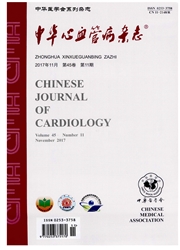

 中文摘要:
中文摘要:
目的探讨重组腺病毒介导的人组织激肽释放酶1(Ad-hKLK1)基因转移对球囊拉伤后的自发性高血压大鼠(SHR)颈动脉新生内膜增生的影响及其机制。方法取SHR,雄性,采用球囊拉伤法建立大鼠颈动脉再狭窄模型,将存活动物随机分为4组,即假手术组(n=6)、单纯拉伤组(n=8)、拉伤+注射对照病毒组(n=8)、拉伤+注射Ad-hKLK1病毒组(n=8)。4周后处死大鼠,测定各实验组再狭窄动脉内膜形态学相关指标。RT-PCR法检测缓激肽受体(B1R和B2R)表达,蛋白免疫印迹法检测细胞周期素激酶抑制蛋白p27Kip1、p21Cip1的表达。结果拉伤+Ad-hKLK1组大鼠颈总动脉的壁腔面积比W/L明显低于单纯拉伤组(1.056±0.149比1.641±0.194,P〈0.001),抑制率达35.6%,内膜/中膜面积比值显著小于单纯拉伤组(0.77±0.09比1.26±0.051,P〈0.01),抑制率达38.8%(P〈0.001)。拉伤+Ad-hKLK1组的周期抑制蛋白p27Kip1和p21Cip1表达明显高于单纯拉伤组(0.55±0.05比0.31±0.06,P〈0.001和0.47±0.06比0.26±0.05,P〈0.001)。球囊拉伤后颈动脉的缓激肽B2R的mRNA表达明显高于假手术组(P〈0.01),而各组间的缓激肽B1R的mRNA表达差异无统计学意义。结论hKLK1基因转移可减轻SHR颈动脉球囊损伤后的新生血管内膜形成,注射外源性人组织激肽释放酶基因可上调缓激肽B2RmRNA表达和p27Kip1、p21Cip1的蛋白表达。
 英文摘要:
英文摘要:
Objective To investigate the effects of human tissue kaUikrein 1 (Ad-hKLK1) gene delivery on the neointima formation in carotid arteries of spontaneously hypertensive rats (SHRs). Methods Carotid artery restenosis was induced in male SHR rats by balloon-injury. Rats were randomly assigned into 4 groups: Sham-operated ( n = 6) ; Angioplasty ( phosphate buffered solution 50 μl, n = 8 ) ; Vector virus ( control virus, 1 ×10^9 IU in 50 μl, n = 8) and Ad-hKLK1 (Ad-hKLK1, 1 × 10^9 IU in 50 μl, n = 8). Rats were sacrificed 4 weeks later. The wall-to-lumen area ratio and intima/media ratio in carotid artery were assessed by image analysis in HE stained sections. The mRNA bradykinin receptor( B1R and B2R) expressions were detected by RT-PCR. The protein expression of the cycle-independent kinase inhibitors p27Kip1 and p21Cip1 were determined by Western blot analysis. Results Wall-to-lumen area ratio reduced 35.6% and intima/media ratio reduced 38. 8% in Ad-hKLK1 treated SHRs compared to angioplasty group ( all P 〈0. 001 ). The expression of p27Kip1 and p21Cip1 increased significantly in Ad-hKLK1 treated SHRs compared with angioplasty rats ( all P 〈 0. 001 ). The mRNA expression of B2R was significantly upregulated in angioplasty rats compared with sham-operated rats (P 〈 0. 05 ) while mRNA expression of B1R was similar between the 2 groups. Conclusion hKLK1 gene delivery may effectively reduce neointimal formation via downregulating bradykinin B2R and up-regulating the expressions of p27Kip1, p21Cip1 signaling pathways in carotid arteries of SHRs after balloon injury.
 同期刊论文项目
同期刊论文项目
 同项目期刊论文
同项目期刊论文
 期刊信息
期刊信息
